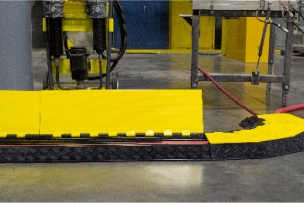If you don’t have secondary containment, you need spill containment. If you do have secondary containment, you still need spill containment. Read on to understand the role of each type of containment and why you should have both.
Spill Containment
The act of stopping a spill is spill containment. When there’s a spill, your first priority — after addressing safety issues — is to stop it from spreading. The sooner you contain a spill, the smaller the area that is affected. And that means it will take less time to clean up the spill.
The thing to remember is that spill containment is part of spill response. Spill response plans often contain different types of spill containment to address different types of spills, including absorbent socks and booms, non-absorbent dikes or even drainage sumps designed to collect spilled liquids. For example, spill containment for a five-gallon oil spill in a warehouse with no floor drains might call for a few socks and absorbent mats, but spill containment for a 30,000-gallon fuel spill heading toward a nearby river is going to take a full arsenal of booms, absorbents and sumps to control.
Secondary Containment
Drums, totes and tanks are examples of primary containers. These containers usually keep their liquid contents in check without incident. But if they contain a hazardous substance, and because they can fail, the EPA requires them to have secondary containment.
The EPA doesn’t specify exactly what secondary containment must look like, but they are clear about what it needs to do: If the primary container fails, the secondary containment structure or device must be able to hold the entire volume that could spill until it can be cleaned up.
That means that secondary containment can be anything from spill pallets or decks to a sloped room that allows the liquid to accumulate at one end until it can be cleaned up. It could be dikes, berms or concrete walls that create a moat around the primary container. In some cases it can even be absorbents. It’s up to you to evaluate your situation and choose the best solutions for your needs.
Why You Should Have Both
Even super-sturdy secondary containment systems can fail and cause a spill, so the EPA requires you to be prepared for spills with appropriate spill containment — even if every container at your facility has secondary containment. That’s why, when people ask us if they need spill containment or secondary containment, our answer is always, “Yes!”
Previously Featured on New PIG's blog.
Shop spill containment solutions from New PIG on MSCDirect.com.





Talk to Us!
Leave a reply
Your email address will not be published. Required fields are marked *